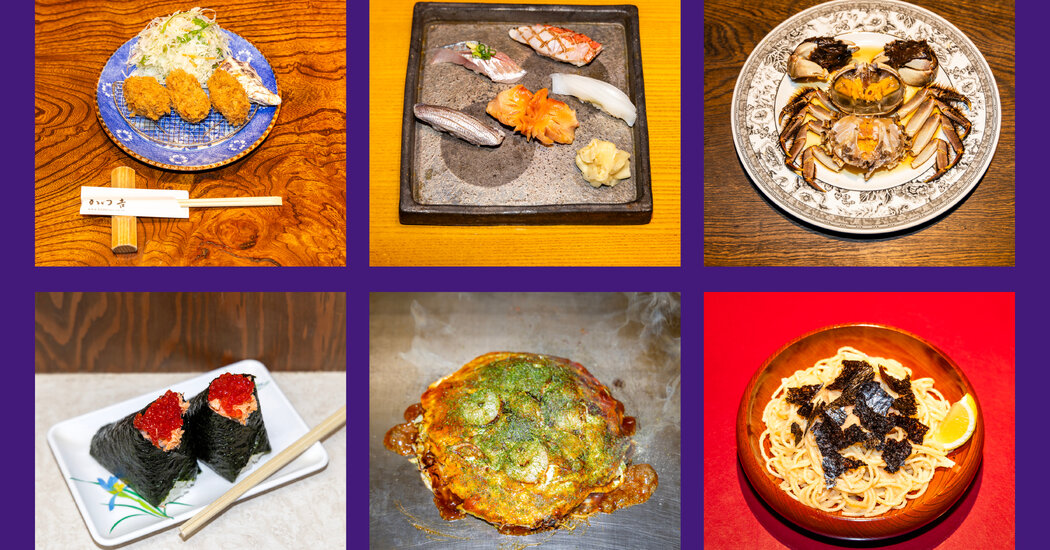More than 200 types of fish and other edible seafood species inhabit Tokyo Bay, and many more live in the waters off Japan. There are delicate, darting fish like isaki and sea squirts like hoya (also known as sea pineapples): things rarely seen on American menus. There’s a bewildering array of bivalves and crustaceans, including a surf clam that’s eaten in two parts, in two different ways: Its adductor muscle is used for one kind of sushi and its crisp flesh and foot for another. There are wispy ice fish that all but disappeared from waters around the Japanese capital, likely owing to land reclamation and pollution, only to make a ghostlike resurgence in recent years. A new species of starfish was even discovered last year not far from Tokyo Bay, although it doesn’t appear to be edible.
That bounty, not to mention the skill and knowledge of Japanese chefs, makes choosing Tokyo’s 25 essential seafood dishes a challenge. Up to the task were Keiji Nakazawa, a sushi master with Sushi Sho restaurants in Tokyo, Honolulu and Manhattan, who lives in New York City; Yukari Sakamoto, a Minnesota-born, Tokyo-based food writer and market guide, who’s married to a Tokyo fish buyer; Sonoko Sakai, a cookbook author who grew up in Japan and lives in Los Angeles; Nao Motohashi, one of Tokyo’s few female head chefs, who serves seasonal modern Japanese cuisine at her restaurant, Julia; Niki Nakayama, a Japanese American chef whose N/Naka restaurant in Los Angeles specializes in kaiseki, or Japanese multicourse haute cuisine; and Hisashi Udatsu, whose Udatsu Sushi in Tokyo, Hong Kong and Los Angeles brings contemporary touches to a venerable sushi tradition.
After all of our six panelists came up with their 10 nominations, we gathered on a video call to narrow the list to 25, as part of T’s ongoing T 25 series (which has also featured essential dishes from Mexico City, Paris, New York City and Italy). There was surprisingly little overlap among our panelists’ picks but also surprisingly little acrimony as we slashed 60 choices to the final selection below.
At the outset of the discussion, all the panelists agreed on one thing: “It’s difficult to make bad sushi in Tokyo,” as Nakazawa said, citing easy access to quality ingredients. But as Sakai pointed out, a fine sushi meal is about far more than the interplay between seafood and rice: A sublime experience, in the end, depends on the relationship between chef and diner. She and the others referred to the importance of “consuming hospitality” along with the meal. “You have to be relaxed to enjoy sushi,” said Sakai, which is why she favors unassuming neighborhood places (see Osushi Isobe, No. 22). The importance of that relationship is also why Nakazawa had such difficulty making his choices. “Selecting the best place in Tokyo is very difficult as you’re selecting the personality of the sushi chef,” he said.
We knew that we didn’t want this list to be sushi-only, and by the end of our two-hour conversation, we’d expanded our scope to include other favorite seafood dishes, from charcoal-grilled mackerel and prawn tempura to clam ramen and a shellfish-laden curry. Eel appears just twice (freshwater and saltwater), but only through a heroic act of discipline. “It’s a disservice to not eat eel when you’re in Tokyo,” said Nakayama. “When I was growing up in Los Angeles, I never liked it. Then I tried the unagi at Ishibashi [No. 11] and thought, Oh! This is what it’s supposed to taste like. I’m on board.”
Above all, the panelists chose to focus on the meals and the purveyors that adhere to a do-no-harm philosophy in which pristine seafood is minimally manipulated and seasonality is key. For that reason, since some fish are available or at their most succulent for only a few weeks a year (Pacific saury, for example, is at its peak in September and October), not all the dishes highlighted here are served year-round. — Hannah Beech
This conversation has been edited and condensed. Though numbered, the entries below aren’t ranked; the dishes appear in alphabetical order.
UNESCO’s decision to add washoku, or traditional Japanese food (wa means “Japanese”; shoku means “food”), to its cultural heritage list in 2013 helped define a term that many Japanese had used but only vaguely understood. A meal made in this manner has to have fresh, seasonal ingredients. It also must be nutritious (low-calorie and low in animal fats) and served with a spirit of hospitality. The ichiju-sansai (“one soup, three dishes”) lunch at Higashiya Ginza — opened by the design firm Simplicity in 2009 — excels in every category. Every month, the restaurant, a modern interpretation of a tearoom, revamps its lunch, tea and wagashi sweets menus to be in sync with the nijushi-sekki, an ancient 24-season calendar that tracks phases of the sun and was imported from China around the sixth or seventh century. During the midwinter Taisetsu (greater snow) and Toji (winter solstice) seasons in December, the lunch usually features buri no saikyo-yaki, grilled Japanese amberjack that’s been marinated for hours in a pale, sweet shiro-miso from Kyoto. Covered in thin kumquat slices and placed atop a dashi broth-stewed daikon disk, the fish takes on the mellow sour-savory notes of its garnishes. The set also comes with side dishes, rice, pickles, dessert and tea. — Kenji Hall
POLA Ginza Building 2F, 1-7-7 Ginza, Chuo
Nakayama: Buri can be a little tough, but the way it was prepared here, it was really tender. And I never would’ve imagined putting kumquats on top of saikyo-yaki, but it just melded so well.
Sakamoto: I stopped by one day recently hoping to squeeze in as a solo diner. The women waiting to be seated for lunch were all exquisitely dressed — many were in formal kimonos. You could tell that this was a special lunch that they had organized in advance.
2. The Black Cod at Uokyu
Founded in 1914 as a fish wholesaler, Uokyu opened as a restaurant in 1940, on a quiet backstreet in Ningyocho, a historic puppet-making quarter in central Tokyo. Now housed in a 1990s building on the same site — with a specialty shop on the ground floor and the restaurant just above — it’s still the place to go for fish marinated in sake lees (also called sake kasu), a residue left over from the process of brewing rice wine. The 1,200-year-old practice, known as kasuzuke, both preserves food and infuses it with a subtly sweet tang, a flavor perhaps best experienced in the form of gindara kasuzuke, buttery black cod that, after soaking in the marinade for a week, is briefly grilled over charcoal. For dinner, it’s served à la carte with a sprig of hajikami shoga, a type of pickled ginger sprout, but at lunch, when the brightly lit dining room tends to be filled with locals, the cod comes with a handful of accompaniments: miso soup, rice (the restaurant serves the highly prized koshi-hikari variety from the Uonuma region of Niigata) and a variety of pickles. — Joanna Kawecki
1F, 1-1-20 Nihonbashi Ningyocho, Chuo
Sakamoto: Nobu [the restaurant chain] is famous for the miso-marinated codfish. [This is] a similar process but, instead of using a sweet miso for marinating the fish, Uokyu uses sake lees. It softens the protein and adds the flavor of sake. In the late ’80s, early ’90s, I worked at Takashimaya department store in Nihonbashi, and I saw they were selling Uokyu’s fillets there, and I thought, Well, what is this fish that everyone is coming to buy? [And then I found out that Uokyu] has its own retail store and restaurant nearby. It’s where the locals go. You don’t see many tourists there.
3. The Black-Throat Sea Perch at Sowado
Nobody accidentally wanders into Sowado, the izakaya that the chef Hideaki Sakai opened in 2020. Located on a backstreet in a quiet area straddling the posh Hiroo and Ebisu neighborhoods, it has an unmarked facade — a concrete wall and a metal sliding door. But it’s become something of a pilgrimage spot for fans of Sakai’s elevated comfort food. The 40-year-old chef has three restaurants in Tokyo, all of which are modern-style izakayas, but Sowado is considered his most ambitious, with dishes like steamed squid dumplings and squid-ink soy sauce. One of his least fussed-over dishes, however, is also one of his most defining: a whole fish, skewered, salted and grilled upright next to a charcoal brazier, cooked on the counter of the open kitchen in the center of the dining room for all to see. The type of fish varies by the season — often freshwater sweetfish in summer or Pacific saury in autumn — but the black-throat sea perch, caught in the Sea of Japan year-round, is a perennial and favorite option. Served with grated daikon and soy sauce, it’s plump and softly springy, with a fatty richness akin to that of toro. — K.H.
Riverside Building, 1st floor, 1-12-15 Hiroo, Shibuya
Nakayama: This is one of the restaurants that’s just very minimal in its design: All they want to do is make simple, straightforward things that Japanese people love. When I went a few years ago, you could tell the fish was of excellent quality, skewered perfectly with the perfect amount of salt and seasoning. We use nodoguro [black-throat sea perch] at N/Naka, too, but it’s super-pricey in Los Angeles. I remember sourcing it for the first time and thinking, Oh my God, it’s more expensive than Wagyu. It’s a small whitefish, and most people think small whitefish are lean, but it’s fatty and tender and melts in your mouth.
Mackerel — plentiful in Japan’s coastal waters but quick to spoil once caught — have been preserved for centuries through charcoal grilling. Quintessential Japanese soul food, the small, oily fish are prepared in just about every household, served in neighborhood shokudo (cafeterias) and sold in convenience-store bentos. But at Aoyama Ototo, a two-and-a-half-year-old seafood restaurant hidden down a flight of stairs in Tokyo’s fashionable Jingumae neighborhood, the humble staple stands out thanks to expert grilling over highly prized binchotan coals from the city of Wakayama, hailed for their clean, slow-and-steady burn. The chef-owner Hiroshi Fukushima, who trained at Tokyo’s Ryugin, a fine dining seafood restaurant, liberally salts his mackerel before cooking it, ensuring that it emerges from the open kitchen moist and tender, with a crisp exterior that’s charred but not blackened. At lunch, the fish comes as part of a set meal with rice, vegetable-laden miso soup and two sides that vary frequently — one recent menu included shirasu (baby sardines boiled in salted water) and fried tofu with ground chicken — all served in pastel ceramic vessels. The mackerel arrives on a plate with grated daikon, mentaiko chili-spiced cod roe and a salad of assorted pickled vegetables. — Melinda Joe
Bell Town Building Aoyama B1, 3-1-28 Jingumae, Shibuya
Motohashi: The moment you step inside the restaurant, you smell charcoal and smoke and fish. While you’re eating, you’re surrounded by the aroma. The restaurant is a three-minute walk from mine. The first time I went was right around the time it opened. You sit at the long counter with a view of the open kitchen. Cooking over charcoal the way [chef Fukushima] does is quite difficult. There’s something theatrical about it. You have to constantly adjust the heat and keep an eye on the food or it will burn. The mackerel skin is smoky and crispy and the flesh is so moist. You have to eat the skin! Quite a few customers from overseas refuse to eat fish skin or eel skin, even though I strongly recommend that they do. It’s so flavorful.
5. The Charcoal-Grilled Seasonal Fish at Sezanne
At Sezanne, a serene space on the seventh floor of the Four Seasons Hotel Tokyo at Marunouchi, the British-born chef Daniel Calvert’s menu reflects his nomadic career, which included stints at New York’s Per Se and Hong Kong’s Belon before he opened Sezanne in 2021. The goal, he says, is to use local ingredients with techniques that “make sense,” but not to necessarily make Japanese food — an approach that’s reflected in his charcoal-grilled fish, which changes with the season. Currently, the kitchen is using kinmedai — a deepwater fish with bright red skin and wide, gleaming eyes — dry-aging it for six days and grilling it skin-side down over binchotan coals. The radiant heat leaves the flesh almost raw with exquisitely crispy skin and, to enhance its smoky char, Calvert brushes on oil that’s been infused with the fish’s own bones. The accompanying white wine sauce, also made with the bones, is whipped and almost foamy, complementing a second, richer sauce of clam stock, tomato water and roasted shrimp heads. For early spring, the dish was garnished with mildly bitter blanched taranome (Angelica tree shoots), feathery aosa (sea lettuce) and plump saltwater clams. — M.J.
Four Seasons Hotel Tokyo at Marunouchi 7F, 1-11-1 Marunouchi, Chiyoda
Udatsu: Out of all the restaurants I’ve been to, Sezanne impressed me the most. We also grill fish over charcoal at our place, so that aspect really resonated. The way [chef Calvert] preserves that sashimi-like texture while still serving it warm is incredible.
The chef-owner Hiroyuki Iwata opened this sliver of a restaurant in 2019, on the site of his mother’s former bento store in the working-class Kamata neighborhood. He uses yamato shijimi, a type of clam sourced from the brackish waters of Lake Shinji in Shimane Prefecture and considered the best in Japan because of its high levels of succinic acid, which adds a distinctive umami flavor. It takes around 80 bivalves, he says, to make enough soup for a single bowl of the restaurant’s signature shijimi shio ramen, a brothy bowl of tender, hand-pulled noodles topped with bamboo shoots, slices of seasoned pork shoulder and thin strands of green onion. With only counter seating, the place accommodates just five customers at a time and serves only 50 bowls a day, meaning you’ll need a reservation. The blackboard menu, next to the ticket machine where customers place their orders, displays the names of the fishermen responsible for unearthing that day’s batch of mollusks. — J.K.
2-1-3 Nishirokugo, Ota
Nakayama: “As a kid I used to visit Japan a lot in the summer, and I drank a lot of shijimi in my miso soup. I remember thinking, How come nothing like this exists in the States? It’s this small clam that has a really nice umami. But as far as I know, it’s not harvested in the U.S. and isn’t available here. So when my friend who lives in Tokyo took me to Shinjiko Shijimi, the ramen was so nostalgic for me. I love clear broth. It’s very light and refreshing compared to thick tonkatsu-style ramen. And Shinjiko Shijimi is just a little place that reminds me of the word “otaku” — it describes people who are so into something that it’s all-consuming. It doesn’t even matter if it’s profitable. It just comes from a place of pure passion, and you can feel that when you go there.”
Soba noodles are now a staple all over Japan, but they originated in Tokyo, during the Edo period (1603-1868). At Edo Soba Hosokawa in Ryogoku — a neighborhood perhaps best known for its sumo stables, where the wrestlers live and train — the chef Tadashi Hosokawa makes them fresh every morning from buckwheat he mills in-house. Though most modern soba recipes rely on either wheat or yam as a binding agent, Hosokawa insists on the traditional (and notoriously tricky to master; since there’s no binding agent, the dough doesn’t come together easily) jyuwari style, made from only buckwheat. Served at a few large communal tables, the perfectly chewy noodles are best enjoyed as part of the zaru soba set, which pairs cold soba with a smoky, soy-based soup (tsuyu) and crispy, mildly sweet, tempura-fried anago, a saltwater eel considered more sophisticated and lighter than the more common unagi (freshwater) variety. For the final flourish at the end of the meal, sobayu, the water in which the noodles were boiled, is mixed with the remaining tsuyu to create a thick and creamy broth. — Vivian Morelli
1-6-5 Kamezawa, Sumida
Sakai: There are thousands of soba restaurants in Japan, but only a handful of people really do soba by hand, like Mr. Hosokawa does. He gets the groats directly from the farmer in the morning, and in the afternoon he mills the flour while he makes the soba to serve the next day and handles multiple other kitchen tasks. It’s a one- or two-man operation. About 12 years ago, I was basically a dishwasher for Hosokawa for about three weeks. I learned so much. I got to experience the intriguing ritual of making dashi at 6 a.m. I learned that everything comes from dashi, and watching the care and precision that goes into making it and the soba was an immersion for me in culture and artisanship.
Nakazawa: Hosokawa is a craftsman. No one is able to optimize oysters in soba like him.
Sakai: I love his oyster soba, but I believe his anago is even more fantastic. The eel is so fresh it curls up when he fries it.
8. The Flounder and Japanese Mustard Spinach at Florilège
In winter at Florilège, in the sprawling new Azabudai Hills complex — home to the city’s tallest building — the right-eye flounder arrives toward the end of the nine-course French dinner. The pillowy fish, covered with Japanese mustard spinach, is served in a brothlike poivre sauce. Most people assume that the fish is the centerpiece of the dish, marking a break from the plates of vegetables that came before it — napa cabbage, turnips and ebi-imo (a type of taro that tastes faintly of shrimp). But the flounder is supposed to play only a supporting role. To the chef Hiroyasu Kawate, it’s the peppery, mildly bitter mustard spinach that should be the primary focus. Since moving Florilège to its current location last year, Kawate, who opened the restaurant in 2009, has organized his menu around seasonal vegetables while cutting back on the meat and fish that he once favored. The restaurant’s dining room and open kitchen share a space, so diners seated at a long communal table or one of two round tables can watch the chefs at work. To make his mustard spinach dish, Kawate lets the flounder air-dry overnight, then steams it with sake, butter and the spinach. For the sauce, he cooks mustard spinach and kombu (kelp) sous vide, strains the liquid, simmers it with peppercorns and dried mikan (mandarin orange) peel and finishes it with dark droplets of charred kombu-flavored oil. The restaurant’s recommended nonalcoholic drink pairing: a mocktail made from fig leaves, rosemary, sage and kiwi. — K.H.
2F Garden Plaza D, Azabudai Hills, 5-10-7 Toranomon, Minato
Nakayama: I went with Carol, my wife and partner, and we were just blown away. It really takes an understanding of flavors and how to combine them to make these dishes come together in such harmony. You could tell that the chef really thought about flavor profiles in addition to the cooking method. And I remember there was a nonalcohol mixologist at one of the counters — another example of otaku, someone super-passionate about his craft.
Twenty-five years ago, the businessman Xu Fu Zao had an idea for an upmarket Chinese restaurant with two separate kitchens — one for Shanghai specialties, the other for Cantonese cuisine — staffed by chefs recruited from Hong Kong and China who could work Japanese ingredients into original dishes. Fureika, occupying four floors of a building in Higashi-Azabu, an upscale residential area with embassies near Tokyo Tower, is the result of that vision. Led by the executive head chef Shi Lan, the kitchen turns out Beijing duck and braised shark fin soup as well as newer creations like sautéed globefish roe and caviar. One of the most consistently asked-for items is the fried prawn wrapped in yuba (a thin film of tofu) with diced scallions. It resembles a petite shrimp tempura — same linear shape, golden color and splayed tail — but with a salty, crunchy exterior that highlights the soft, juicy crustacean inside. The chefs in charge of the restaurant’s Shanghai cuisine finish the dish with a splash of Shaoxing wine. Fureika’s fried prawn is available at five of the 10 other restaurants that Xu runs, including Chugoku Hanten, in the neighboring Roppongi district, which he opened shortly after he arrived from Shanghai in 1975. — K.H.
3-7-5 Higashi-Azabu, Minato
Udatsu: Like sushi, in Chinese cuisine, dishes come out one at a time. It gives you a chance to really appreciate each one. I chose the kuruma prawn at Fureika because it was in yuba (tofu skin) and fried in a way that you could really enjoy the texture. It inspired me to make my own version with a Japanese twist. Their Peking duck is really good too.
10. The Gizzard Shad Bocadillo at Acá
The bocadillo at Acá looks nothing like the Spanish sandwich that it’s named after. The dish — slender, silver-skinned fillets of raw gizzard shad (kohada) draped over garlic slices, shiso leaf and a crunchy sliver of tomato bread — calls to mind a piece of sushi. That’s no accident: The chef Tetsuo Azuma marinates the fish in a three-vinegar dressing that’s commonly used for sushi, and makes it small enough to eat in one bite. His 13-course menu, served at a counter facing an open kitchen and in a small private room with walls of clay and straw, alternates between grilled fish and meat and surprising interpretations of gazpacho, ajo blanco and croquetas. Azuma originally opened the restaurant in 2013, in his hometown of Kyoto, to change the image of Spanish cuisine as inexpensive wine-bar fare in Japan. By the time he moved to Tokyo’s Nihonbashi district, across the street from Japan’s central bank, in 2020, he’d made his point and become a role model and mentor for a younger generation of chefs (he trains them at his less expensive offshoot, Shokudo Acá, in the city’s Toranomon neighborhood). His other signature dish is a seafood paella that, depending on the time of year, might feature horsehair crab, snow crab or firefly squid and, like the rice that comes at the end of a kaiseki meal, is offered as the last savory bite before dessert. — K.H.
2-1-1 Mitsui Bldg. 2, 1F, Nihonbashimuromachi, Chuo
Nakazawa: I believe this combination of kohada and bread is truly groundbreaking — perhaps the first of its kind in the world. I was profoundly impressed. And at Acá, the Japanese spirit of omotenashi — offering heartfelt service and attention to detail — is deeply ingrained and shines through in every aspect of the experience.
The recipe for grilled eel at Edogawa Ishibashi, a fourth-generation family-run restaurant in the tranquil Bunkyo area, hasn’t changed since the place was founded in 1910. Here, inside a traditional detached house with weathered timber walls and tatami matting, chefs first fillet and skewer the unagi (a freshwater variety of the fish) and then lightly charcoal grill the pieces. They’re then steamed, to impart an extra-tender texture, and grilled for a second time before being coated with a caramelized soy glaze and served atop rice in lacquerware boxes, many of which have been passed down through generations and were made in the city of Wajima (the country’s traditional center of lacquerwork). The pickled Japanese radish, cucumber and Chinese cabbage served alongside — which are all fermented differently, some vegetables in rice bran and salt, some in sake lees — are almost as popular as the eel itself, and accompanied by a bowl of kimosui, a light broth made from boiled eel livers, Japanese parsley and shiitake mushrooms. Over the years, Ishibashi has also developed a reputation for its sake selection, thanks to its proprietor, Ayuko Nemoto, a certified sake sommelier. Her pick to start off the evening: Kiyasho Shuzo’s Jikon Junmai Daiginjo Yamada Nishiki, which has a delicate aroma and just the right amount of acidity. — J.K.
2-4-29 Suido, Bunkyo
Nakazawa: When thinking about eels, you have to think about the balance of the following factors: how the eel is steamed and roasted, the sauce and how the rice is prepared. In Ishibashi’s case, the unaju [broiled or grilled eel served over rice in a lacquered box] is supplemented by its fantastic pickles. The balance overall at Ishibashi is at a very high level.
Nakayama: My parents were in the seafood business, and sometimes they’d have live eel, but they didn’t know how to deal with it. When I first went to Ishibashi, I thought, This is how you’re supposed to do it. It’s such a comforting dish. The technique and the precision are incredible. The unagi sauce is like a mother sauce — they save it for years and years and keep adding to it. It has history. It’s like no other sauce.
For more than a century, the backstreets of the Ginza shopping district have been the city’s epicenter for Edomae sushi (combining fresh seafood from Tokyo Bay and bite-size nigiri rice balls made with vinegar) in Tokyo. This is where you’ll find the illustrious Kyubey, which opened in 1935 and has consistently ranked among the city’s finest sushi restaurants. In the 1940s the original owner and chef Hisaji Imada invented his signature dish, the gunkan-maki (battleship roll), a ball of vinegary rice wrapped with a wide seaweed strip that holds various fillings. He was also the first to stuff the roll with layers of creamy uni (sea urchin). Back then, uni was considered too soft and strange for sushi, but Imada experimented with it at the request of a customer from Hokkaido (the prefecture that harvests the most uni in the country) and succeeded, eventually spawning imitators across the city. Kyubey’s gunkan-maki with ikura (salmon roe) is another enduring favorite. Today, Ginza Kyubey is run by the founder’s grandson, Kagehisa Imada, who serves around 40 types of fish bought daily at Toyosu fish market. He’s inherited his father and grandfather’s rice recipe (vinegar and salt only), and uncompromising standards for fish. The 70 chefs who work at Kyubey’s seven locations spend a decade in training before they’re allowed to prepare sushi in front of customers. And every one of them learns the proper way to prepare the gunkan-maki. “The moment I make it, I hold it out in the palm of my hand and say to the customer, ‘As soon as possible.’ I want them to eat it while the seaweed is crispy,” says Imada. — K.H.
8-7-6 Ginza, Chuo
Sakamoto: Ginza Kyubey is the gold-standard sushi restaurant that a lot of Tokyoites will experience once in their life. It’s more accessible than most high-end sushi places, both because it’s much larger and more welcoming. People go there for a special occasion, like a kid’s graduation. And though all of the sushi is delicious there, I always appreciate the gunkan-maki — it’s just fascinating to me that the concept of wrapping the nori around the vinegared rice was created there and now it’s around the world.
13. The Kaki Furai at Katsukichi
A much-loved local chain, Katsukichi specializes in thick and hearty tonkatsu, a breaded and deep-fried pork cutlet. But in the winter months, diners come here for a seasonal specialty: kaki-furai, or deep-fried oysters. Delivered fresh from Tokyo’s Toyosu market every morning, the juicy bivalves — each about the size of a palm — are a meal in themselves, battered with panko, fried to order and served simply, with a cabbage salad, as well as tonkatsu sauce, mustard and homemade tartar sauce. While kaki-furai is by no means an uncommon dish, Katsukichi’s version is exceptional, notable for its extra-crisp exterior and a soft, creamy middle that makes clear why the Japanese refer to oyster liquor as “the milk of the sea.” Don’t waste time taking photos: This is a dish best eaten hot. — Hiroko Yoda
Multiple locations
Sakamoto: The other thing I love about this place [besides the fried oysters] is the interior. It’s filled with dark wood and mingei (Japanese folk art). A lot of restaurants will use basic dishes that can be thrown into the dishwasher, but Katsukichi uses these traditional ceramics, which are meant to make your everyday experience more beautiful. [My other favorite thing here] is that when you’re offered rice, they say, “Would you like white rice or rice with shiso?” So they’ll chop up shiso leaves and stir that into the rice, which is so yummy.
It’s hard to make a Japanese meal without katsuobushi flakes. The shavings of smoked, fermented, sun-dried katsuo (bonito or skipjack tuna) are an essential flavor base for soups, stews and dipping sauces. At Katsuo Shokudo, located on a residential backstreet near neon-lit Shibuya, the chef and owner Mai Nagamatsu has given katsuobushi top billing. From behind the 10-seat restaurant’s U-shaped counter, she scrapes the hardened fish blocks over an old-fashioned kanna (a wooden plane fitted with a steel blade), producing fragrant, papery strips that she heaps on top of rice and serves with a meal set, from 8:30 a.m. to 1:30 p.m. Fridays to Tuesdays. (It’s inspired by a similar meal she had while visiting producers during the decade or so that she spent traveling and learning about her country’s centuries-old history of katsuobushi-making and its fading traditions. Nagamatsu opened her restaurant in 2017, in part to promote awareness about this lesser-known aspect of Japan’s food culture.) Nagamatsu uses only the highest grade of katsuobushi, called honkarebushi, which takes six months to make. It goes into almost every dish on the menu, from the miso soup to the side dishes of stewed hijiki with lotus root and sautéed udo (spikenard). But the best way to experience the smoky intensity of katsuobushi is on its own: Pick off a few strips and let them disintegrate on your tongue. — K.H.
GranDuo Shibuya B1F, 7-12 Uguisudani-cho, Shibuya
Sakamoto: This is something you’d never have at home. People don’t have the special tool to shave katsuo. Once the fish is smoked and dried, it becomes as hard as a piece of wood — people call it the hardest food in the world. But many of us have preshaved katsuobushi in our homes, so it’s a special treat to have it freshly shaved and just put over the rice. This natural umami that comes from it fills your mouth and you become like a little kid eating it.
15. The Katsuo Tataki at Hyene
Katsuo (bonito or skipjack tuna) is a cornerstone of Japanese cuisine that holds special significance in the coastal prefecture of Kochi, on the island of Shikoku, where the fish is still abundant and was designated a regional symbol in 1988. The katsuo tataki technique — which involves searing the fish on the outside while keeping it raw inside — originated in Kochi, and this preparation is now served all over the country, everywhere from casual izakaya to refined kaiseki restaurants. Typically, the fish is offered alongside sliced raw garlic and onion and dipped in either simple sea salt or ponzu (soy sauce enlivened with citrus), but at Hyene, set in a restored wooden townhouse in Tokyo’s wealthy Omotesando neighborhood with eight counter seats and one small private room, the chef Yoko Kimoto’s version reflects her Korean-Japanese heritage. Loosely inspired by mulhoe — a Korean preparation of sashimi and vegetables in a chilled, vinegary broth — the ruby-red skipjack fillet is seared over dried rice stalks, imparting a subtle smokiness. The final dish resembles a tower, with thick slices of katsuo layered with a julienne of myoga (tender Japanese ginger) and cucumber. A tangy sauce of whole-grain mustard and umeboshi-vinegar mayonnaise — made with the brine from plum pickles — is drizzled over the top, while a silky pool of okra purée infused with white wine vinegar lies beneath, for dipping. — M.J.
5-13-14 Jingumae, Shibuya
Udatsu: The restaurant had only been open for about six months when I first went. I saw it on Instagram, and it sounded interesting — Korean and French fusion by a female chef. Straw-grilled katsuo is a traditional Japanese dish, but [chef Kimoto] added a French-style okra sauce, which brought out this distinctive flavor of katsuo. It was innovative and, more importantly, really delicious.
16. The Marinated Crab at Bar Odin
In Ebisu, a restaurant-packed neighborhood south of Shibuya, a weathered wooden door in the basement of a nondescript building leads to Bar Odin, a cavernous, moodily lit space overseen by Takahiko Kikuchi. While the drinking options run the gamut — the ample spirit collection includes bottles of French cognac from the early 1900s — regulars know that in fall and winter, the plate to order is Kikuchi’s rendition of Shanghai drunken crab, the Chinese delicacy in which live crustaceans are submerged in a booze-heavy marinade. Here, he soaks the crabs for up to a week in a bath made up of limited-edition sake, 10-year-old mirin, a soy sauce from Wakayama (where the soybeans are roasted over firewood) and cognac, along with a handful of aromatics like ginger, star anise, dried tangerine peel, sansho (a Japanese pepper) and a single dried chile to add a touch of heat. Before plating, he snips the legs and claws to fan around the carapace, then opens the shell to reveal the bright orange tomalley (an unctuous, fatty organ). The tomalley comes away easily with a spoon, but the delicate meat demands both dexterity with scissors and patience to extract. It’s an unavoidably messy process, requiring a finger bowl and multiple towelettes. (As at many Tokyo bars, there are rules: Each patron must order at least one drink and one dish or two drinks.) — M.J.
K-1 Building B1F, 1-8-18 Ebisu, Shibuya
Udatsu: It’s rare to find such serious food coming out of a bar. Kikuchi-san is really meticulous with his seasonings, and he also sources unique ingredients, including bear meat. But the Shanghai crab is my favorite dish there — it goes very well with Champagne.
17. The Mixed Seafood Okonomiyaki at Momijiya
A savory pancake filled with cabbage and other assorted produce, the okonomiyaki (okonomi means “as you like it” and yaki is “grilled”) emerged as a hearty staple during post-World War II rice shortages. Two distinct styles developed in two different cities came to define the dish: In Osaka, ingredients are mixed directly into the batter, and in Hiroshima, they make it as a layered concoction stuffed with noodles and whatever else is on hand. Momijiya, which opened in Tokyo in 2012, specializes in the Hiroshima style. There are now two other locations, but the original — in the central Iidabashi neighborhood, near Tokyo Daijingu, the Shinto shrine where couples go for blessings — is the most popular, especially at dinnertime. A casual 25-seat spot decorated with paintings of maple leaves (or momiji, in tribute to the restaurant’s name), it’s anchored by a large flat-top iron grill manned by one or two chefs. Along the perimeter are 10 stools from which patrons can watch their okonomiyaki of choice get made. Arguably the most decadent choice is mixed seafood (kaisen-mikkusu), the base of which is a freshly made crepe sprinkled with dried fish and kelp powders. Next comes a mound of shredded cabbage, bean sprouts, green onions and pork belly slices. Using two spatulas, the chef flips the pile and then presses it down with a metal weight, before sliding the stack onto a tangle of udon or yakisoba noodles. Then they crack an egg into a perfect circle elsewhere on the griddle and add a sizzling mix of oysters, shrimp, scallops, whelks and squid. The two halves are joined with the egg layer on top, then brushed with Worcestershire-like Otafuku sauce and dusted with dried seaweed flakes. Served hot, the okonomiyaki is eaten with a mini spatula and chopsticks and, for those craving even more decadence, a squirt of mayonnaise. — M.J.
4-2-6 Avance Iidabashi Bldg. 2F, Iidabashi, Chiyoda
Sakai: Okonomiyaki is one of my favorite street foods, and I prefer the Hiroshima style — it’s lighter. This place is like a diner where you can watch the chef make like 20 okonomiyaki at a time. The performance is incredible.
18. The Onigiri With Grilled Salmon and Roe at Bongo
Soft-cornered triangles of white rice shaped around fillings and wrapped in sheets of nori, onigiri are available everywhere in Tokyo, from convenience stores and train stations to fine dining restaurants — they’re the Japanese equivalent of sandwiches. But the onigiri at Bongo have earned enough of a reputation that locals stand in line for hours for them. The 10-seat, 65-year-old restaurant resembles an American diner, with stools, a Formica counter and menu-covered walls. Fifty-six ingredients are displayed behind glass, like fish at a sushi bar, and the chefs make each onigiri to order, turning out up to 2,000 rice balls a day, with flavors such as tuna mayonnaise and littleneck clam. Sujiko-sake, Bongo’s signature variety, is stuffed with salmon roe and grilled salmon, offering a briny, savory contrast to the warm white rice. — H.Y.
2-27-5 Kita-Otsuka, Toshima
Sakamoto: The woman behind Bongo, Yumiko Ukon, started this hype with onigiri. She’s kind of a celebrity in Tokyo because of these large, handmade onigiri — almost twice the normal size. The main shop in Otsuka is still super-popular, but some of her employees have opened their own restaurants with her blessing. There’s also a sister onigiri restaurant at Haneda airport called Konga. Every time I’m at Haneda, I make a point of getting the Bolognese onigiri there.
A few minutes’ walk from Shinjuku train station, the city’s busiest, Shinjuku Kappo Nakajima is best known for its elegant kaiseki-style dinner menu, but the 30-seat basement-level restaurant, with wood-slat paneling and a modern stone mosaic affixed to the wall of an old kiln behind the bar, also serves an affordable lunch centered on sardines. In the standout dish, the small fish are simmered and served over ochazuke, a hot, porridgelike soup made from bonito-based dashi broth and rice. Sardines aren’t typically served in upscale restaurants, and ochazuke is generally offered at the end of a meal as an economical way to use up leftover rice, but here they become something special in the hands of the chef-owner Sadaharu Nakajima, whose father founded the restaurant in 1962. To infuse the fish with an herbal, almost cinnamony flavor — and soften their edible bones — he wraps them in red shiso leaves with pickled plums, letting them sit for 10 hours before cooking. As a final flourish, he sprinkles the sardines with tiny roasted rice crackers, which add crunch, as well as chopped mizuna leaves for a peppery note. — V.M.
3-32-5, Hihara Building B1, Shinjuku
Sakai: The chef [Sadaharu Nakajima] is really famous because he was on a Japanese TV show. He lets his apprentice serve lunch, so it’s much cheaper than dinner. It’s a three-minute walk from Isetan department store, which has the best food hall. A lot of people will do their shopping, then go to Shinjuku Kappo for lunch. I love the ochazuke. When you break up the cooked sardines and add them to the soup, you get to smell the smokiness. It isn’t fishy at all, just really good.
20. The Sea Bream Capellini at Sel Sal Sale
Each element of the 11-course dinner menu at Sel Sal Sale, in Ebisu, combines Japanese and European flavors. German-style sourdough bread is flecked with tiny slices of Japanese burdock root and topped with both prosciutto and piquant mirin lees, while the gnocchi is flavored with sesame seeds from Kikaijima Island in Kagoshima Prefecture. But it’s the sushi-pasta mash-up, served as a first course, that’s perhaps most memorable: thinly sliced raw madai (Japanese sea bream) — a local species considered a delicacy and often reserved for celebrations — arrives atop a single mouthful of angel hair twisted around a fork. Because the components are minimal, the focus is on the delicate, olive-oil drizzled fish, expertly seasoned by the chef Masahiro Hamaguchi, who travels throughout Japan to source special varieties of salt for his aptly named restaurant. The sea bream capellini gets a sprinkle of za you zen, a salt from Yamaguchi Prefecture that has delicate flakes that vary in flavor with the seasons. — H.Y.
Hagiwara Building 1F, 1-16-7 Ebisu-Nishi, Shibuya
Motohashi: Sea bream and capellini is something that you’re likely to see on the menu at a lot of Italian restaurants in Tokyo, but Hamaguchi-san’s is next-level. I have no idea how he does it. It’s a secret. I’ve worked with him at events, so I know how much of a pro he is at turning even the most ordinary ingredients into something that tastes incredible.
21. The Seafood Soup Curry With Mixed-Grain Rice at Kaju Tokyo
Japanese curry is usually synonymous with kare raisu, a thick stew of meat and vegetables served over rice. But at Kaju Tokyo — a 23-seat restaurant in the wealthy residential neighborhood of Ichigaya, with black-and-white tiled floors, leather banquettes and a clean-lined wood bar — people come for the seafood soup curry, a rich, spicy, tomato-based broth packed with shrimp, clams, squid and scallops. Unlike so many other beloved local dishes, Japanese soup curry is a fairly modern addition to the food scene — it’s said to have been created in the city of Sapporo, on the northern island of Hokkaido, sometime around 1970, and inspired by Chinese- and Korean-style medicinal soups. At Kaju Tokyo, which opened last May, the recipe calls for 19 different spices, including coriander, cinnamon, chiles and turmeric, each intended to provide a specific health benefit. The menu features hand-drawn instructions on the various ways to eat the curry — by adding the rice to the bowl, by pouring the curry over the rice or by slowly ladling the curry onto the rice. Whatever method you choose, it’s a messy undertaking, so much so that each diner is provided an apron. — V.M.
Grace Wahei 1F, 3-5-5 Kudan-minami, Chiyoda
Sakai: They say that the average Japanese person eats like one and a half dishes of curry every week. It’s the national food of Japan, even though it didn’t come from Japan. But we created a Japanese-style curry. For decades, what we considered curry was made with an industrial roux that has all these additives and you never know what spices you’re really eating. Kaju Tokyo makes yakuzen curry, which emphasizes fresh seasonal and natural ingredients and is influenced by the use of spices and herbs based on Indian and Chinese medicinal principles. It’s really good and served in a sizzling hot pot.
Sushi in Tokyo tends to be a choice between extremes: inexpensive takeout chains and kaitenzushi (conveyor-belt) restaurants or costly omakase tasting menus. Osushi Isobe sits somewhere in between. The chef Yuji Ueno and his wife, Fumi Watanabe, opened their 16-seat restaurant in 2016, on the ground floor of an apartment building near Yoyogi Park, and it’s since become a much-loved neighborhood spot for excellent, affordable sushi. Several times a week, Ueno heads to Tokyo’s Toyosu Fish Market in the early morning to source the day’s catch, but he also relies on overnight shipments of barracuda, parrotfish and black-throat sea perch (nodoguro) from suppliers in Nagasaki. Having worked at sushi and washoku kitchens around the capital for more than two decades, Ueno realized that there were few high-quality sushi restaurants where locals could drop in alone or with young children for a casual meal. He makes his nigiri small to keep prices low and lets customers order any combination from about 30 types of fish, ranging from the more familiar aji (horse mackerel), akagai (ark shell) and kinmedai (golden-eye snapper) to rarities such as higesoridai (short-barbeled velvetchin). Ueno’s insistence on freshness extends to his izakaya-style specials of monkfish liver, female snow crabs and sea urchin- and mushroom-packed chawanmushi (steamed egg custard) that come and go with the seasons. — K.H.
2-11-101 Motoyoyogi-cho, Shibuya
Sakai: The problem with Tokyo right now is that it’s inundated with tourists because of the exchange rate. You get them in busloads. It’s changing the whole feel of the city. But you can still find these authentic places with a neighborhood feel. Isobe is just this mom-and-pop place that a friend introduced to me. You sit at the sushi bar and you have a conversation with the chef. What’s in season today? What’s looking really lively? We tried a lot of seasonal fish like sayori, silverfish and some squid. I was very happy. My friend and I fought over the last squid.
23. The Tarako Pasta at Kabe no Ana
A simple concoction of spaghetti, salted cod roe and butter garnished with toasted nori, tarako pasta is a 20th-century invention that became wildly popular in both restaurants and home kitchens during the itameshi (a portmanteau of the Japanese words for “Italian” and “food”) craze of the 1980s and ’90s. The original version is said to have been invented at the Shibuya restaurant of the small Japanese chain Kabe no Ana (translation: “Hole in the Wall”) by its founder, Takayasu Narimatsu, after a customer requested caviar on their spaghetti. (Pasta had been introduced to Japan in the late 19th century and really took off during the postwar American occupation.) Today, the restaurant — which has a retro charm, with orange banquettes and faux-brick accents — uses tarako (cod roe) along with cultured butter from Hokkaido and nori harvested from the Ariake Sea. At old-school coffee shops and family restaurants in Japan, where the dish has become a staple, the pasta typically comes topped with preshredded nori, but Kabe no Ana maintains its distinctive presentation, serving it in a wooden bowl with whole sheets of nori on the side, allowing diners to tear the seaweed themselves and dip it into the creamy sauce, thickened with roe. A squeeze of lemon brings welcome acidity. — M.J.
Kasumi Building 1F, 2-25-17 Dogenzaka, Shibuya
Nakayama: I first ate tarako pasta at Kabe no Ana when I was a student in Tokyo. It was like a feeling of home, this wonderful combination of Japan and America all at the same time. I wanted to eat it all the time.
The chef Kazuhito Motoyoshi is something of a tempura scientist. About eight years ago, he realized that chilling the flour for his batter to -60 degrees Celsius (-76 degrees Fahrenheit) with liquid nitrogen resulted in an extra-crispy, almost feathery crust. Through further experiments, he came up with his signature frying blend of canola, corn and traditionally pressed Japanese sesame oils, which, he says, delivers a delicate texture with minimal grease. At his 19-year-old, eight-seat Tempura Motoyoshi, in the popular dining-and-drinking neighborhood of Ebisu, he serves a tempura-only omakase menu. For many, the highlight of the meal arrives just before dessert — the kakiage tendon (tempura rice bowl), in which a crunchy cluster of hotate kaibashira scallops from Hokkaido mixed with small shrimp from Kumamoto is set atop suzu-hikari rice, a variety from Nagano whose medium-firm texture Motoyoshi considers the ideal foil for tempura. The bowl is drizzled with a sweet, soy-based sauce and served with a wedge of yuzu. — J.K.
3F, Granbell Ebisu IV, 2-8-11 Ebisunishi, Shibuya
Nakazawa: Shrimp is at its most delicious when it’s prepared as tempura — more so than as sushi. I [nominated] kakiage tendon because it’s a cohesion of multiple skills.
Udatsu: Temperature is another factor to consider. It’s especially fascinating when the temperature of the tempura rises when one bites into a shrimp tempura.
Nakazawa: Motoyoshi provides tempura at room temperature in contrast with the trend today [of serving] freshly fried tempura. It’s important to consider that not all tempura tastes great when hot. For instance, sweet potato tempura tastes better at room temperature because its sweetness increases after time. Motoyoshi provides tempura for its kakiage don at different temperatures — all optimal. Only Japanese professionals would focus on small details like this.
The owner-chef Hideki Ii’s 11-year-old Sumibi Kappo Shirosaka restaurant in the upscale Akasaka district is an homage to the ryotei (private-dining establishments styled like homes) that once thrived in the neighborhood. To reach the dining room, you walk through a lantern-lined garden and step through a white noren curtain to enter what looks like a small house, outfitted with a 10-seat counter opposite the kitchen and an adjacent private dining room that seats up to six. Ii’s signature dish — served as part of the omakase menu — is a base of creamy uni (sea urchin) and finely chopped tuna topped with a small puff of fried semolina and rice flour, similar to the Indian snack pani puri. Crisp and hollow, the puff is filled with a gelée made from kombu (seaweed) and bonito (tuna) dashi and topped with a scoop of Osetra caviar and a single raw quail egg yolk. Ii encourages diners to use a spoon to crush the components and mix them together, ensuring that each bite delivers all the varied textures — J.K.
6-3-9 Akasaka, Minato
Motohashi: Ii-san only offers an omakase course. You sit at the counter and eat the food that he’s decided to make that day from the ingredients that he’s sourced from all over the country. He prepares the meal right in front of you and explains in detail what everything is. It’s really relaxing. The water from the bamboo fountain in the garden [just outside the dining room] makes a hollow sound when it hits a stone, which you can hear while you’re eating. His raw tuna and sea urchin dish — all [the flavors] in one plate — brings me happiness. His handmade soba with grated karasumi (dried salted mullet roe) is also so good, and the Japanese ceramics and lacquerware that he serves his food on are beautiful. Ii-san and my husband go way back. After we finish service for the night, we like to meet up with him for drinks in Roppongi.
Photo production: BEIGE









